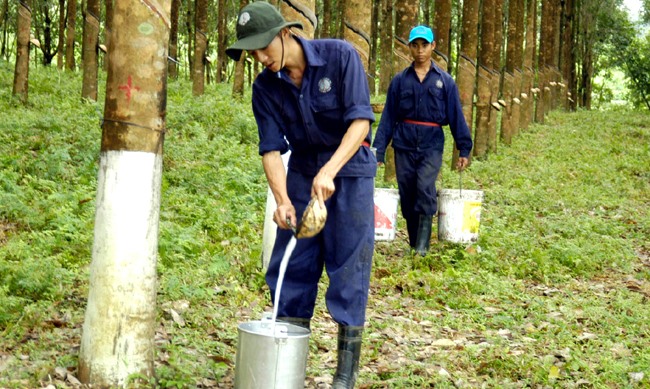 Economy
Economy

Việt Nam’s rubber plantations need to obtain sustainable management certifications in order to raise product value and enter global markets, participants said at a workshop held in HCM City on Monday.
 |
| Workers exploit rubber latex in the central province of Quảng Nam. Việt Nam’s rubber plantations need sustainable management certifications to raise product value and enter global markets. — VNA/VNS Photo Vũ Công Điền |
HCM CITY — Việt Nam’s rubber plantations need to obtain sustainable management certifications in order to raise product value and enter global markets, participants said at a workshop held in HCM City on Monday.
Võ Hoàng An, deputy chairman of the Việt Nam Rubber Association, said the rubber industry had developed strongly into having the largest cultivation area among the country’s industrial perennial plants, with 976,400ha last year.
Việt Nam ranks third in rubber output as well as export of natural rubber products in the world, he said. Enterprises exported more than one million tonnes of natural rubber worth US$1.67 billion last year.
In addition, processed rubber exports went up 17.9 per cent a year in recent years, reaching $1.64 billion last year. Export turnover of rubber wood and rubber wood-based products reached $1.54 billion last year, up 26.2 per cent over 2015.
“In recent years, the world has become increasingly concerned about the reduction of the area and quality of natural forests, which has a great impact on the natural environment and the ability to provide forest products,” he said.
“The tendency to shift to using forest products that are legally sourced or certified for sustainable management in the world market has increased in the context of global climate change,” An added.
Although Việt Nam has started adopting international practices for sustainable forest management and forest certification, certified forests with sustainable management represent only a very small percentage of the total forest area in Việt Nam.
Lê Thiện Đức from the World Wildlife Fund Vietnam said about 229,700 ha of forest areas, largely plantation forests, have FSC (Forest Stewardship Council) forest management certificates. Most of them plant acacia and melaleuca, while no rubber plantations have such certificates.
The country has set a target to have 500,000ha of forest with forest certification by 2020, according to Đức.
Vũ Thị Quế Anh, FSC project coordinator, said many countries issued regulations to allow only wood of verified legal origin to enter their markets. Natural rubber is an important product worldwide, and a long-term and sustainable supply source is critical, she said.
FSC’s certification scheme ensure traceability of deforestation-free products from well-managed forests and generates assurance that product claims are truthful and credible.
In recent years, leaders of large rubber enterprises paid more attention to the importance of forest certification.
Trương Minh Trung, vice president of the Việt Nam Rubber Group, said: “In the long-run, we must strive to implement FSC certification. Each year, we liquidate about 10,000 to 12,000ha of rubber or one million cubic metres. If we have the FSC certificate, the wood will sell at prices 10-15 per cent higher,” he added.
Organised by the VRA and WWF Vietnam, the workshop aimed to raise awareness of sustainable rubber plantations and FSC certification for rubber enterprises in Việt Nam. — VNS




